How to Identify RPA Opportunities
Large companies and SMEs across all industries benefit from robotic process automation (RPA). Across departments, you'll find a significant amount of time-consuming routine tasks that employees don't enjoy, making the potential need and value of RPA undeniable. As a non-invasive, low-code technology, RPA holds the promise of rapid deployment with fast results.
Knowing this, you need to know how to approach implementing an RPA program at your company. Before implementation comes analysis. Identify processes that are truly suitable for automation to get the maximum return from your investment in RPA.
Demand check: RPA potential across departments
Your automation journey begins with a walk through the business departments in search of potential RPA use cases. Take a look at your company's processes from the following perspective: “A good candidate [for RPA] is a task that is a bottleneck in a larger process that may take hours of manual work.” - Dennis Gannon, VP of Research at Gartner
These are all the time-consuming, often deadline-bound tasks that bore or stress your qualified employees. These tasks are also frequently prone to human error and need to be reworked. They cost too much, tie up valuable resources in your company, and block value-adding activities.
Check your departments for monotonous tasks that are good candidates for RPA. For example, after deducting payroll, time recording, personnel file management, and organizational tasks in the context of recruiting, onboarding, and offboarding , your HR staff hardly has any time left for leadership coaching and personnel development. In purchasing and finance, the day-to-day operational business of comparing supplier conditions, writing proposals, booking invoices, or creating reports prevents a strategic focus. And your IT team is supposed to be driving your business forward with innovative solutions, but instead spends all day in a traditional administrative role – assigning passwords, installing software, or applying patches.
Process automation demand is potentially everywhere – so why not quickly implement an RPA solution and let the bots take some work off your employees’ shoulders? It’s an appealing idea, but a suboptimal approach.
RPA isn't just a tool – it’s a lever for process optimization
Company-driven processes are frequently not strategically implemented top-down. Rather, they evolved bottom-up in daily business and sprawled wildly over the years. The very departments that like to initiate RPA projects and are supposed to benefit from automation maintain numerous highly individualized and proven, but often not very efficient workflows.
"If you digitize a shitty process, you end up with a shitty digital process." Take that popular statement, replace "digitize" with "automate," and the equation is still true. RPA initiatives that are simply slapped on top of the existing process landscape are not realizing the full potential of the technology:
“[In] many companies […] RPA implementations support the “as-is” process, with no improvement or examination of the current process steps that are automated. As a result, they may achieve modest savings, but […] will miss out on opportunities to dramatically improve process outcomes, quality, costs, and cycle times.”
So even if you initially discovered a promising automation potential across your organization and would really love to start RPA right away, step back and analyze what might happen. Don't just give your employees a low-code tool to automate some tasks. Take a mindful step back and use the introduction of RPA as an opportunity for process reengineering:
“The companies we have seen achieve the greatest success in deploying RPA are those who combine it with the disciplines of process redesign and continuous improvement. […] RPA in which the “P” stands for process improvement or innovation is a much more valuable tool than simple task automation.”
Thomas H. Davenport and David Brain: Before Automating your Company’s Processes, Find Ways to Improve them
As-is-assessment: Documenting processes
As a basis for subsequent optimization, map the current process landscape first. You’ll most likely find that there is no (consistent) documentation available. There may be single workflow descriptions scattered in drawers or digital folders, in Word, in Excel, in Visio, as free-text descriptions, as click paths – and most often already outdated. As a rule, the up-to-date process knowledge is stored in your employees’ heads.
Bring this knowledge to light, and take another spin through your company; determine how processes are actually executed in your organization. Document the processes in your company on three levels:
- Core processes contain all activities that directly add value: The manufacture of a product or the provision of a service. They typically run across different departments. E.g. The order-to-cash process ranges from a customer’s inquiry to their payment posting. This affects sales, warehousing, production, shipping, and accounting. Conduct a workshop with all department heads involved and map a higher-level view of the entire core process.
- Supporting processes are sub-processes of the core process: These are typically department-related, e.g. order processing in sales or invoicing in accounting. In workshops with department managers and employees, record the logical sequence of the individual process steps, the actors involved, and the required exchange of goods or information.
- Tasks: Look at the individual process steps in detail, e.g. invoicing. Zoom into the task level and use questionnaires or employee interviews to record the sequence of analog or digital tasks that employees perform to complete a process step. Make sure to document the duration and frequency of the activities. This is the level at which people actually work, and at which the RPA bots will take over suitable tasks in the future.
Workflow visualization: Modeling processes
Visualize the high-level overall processes and assigned sub-processes. Apply the standard business process model notation (BPMN) 2.0. BPMN models processes as a graphical flowchart and helps to visualize the process logic including involved actors, resources, dependencies, and activities in a comprehensible way.
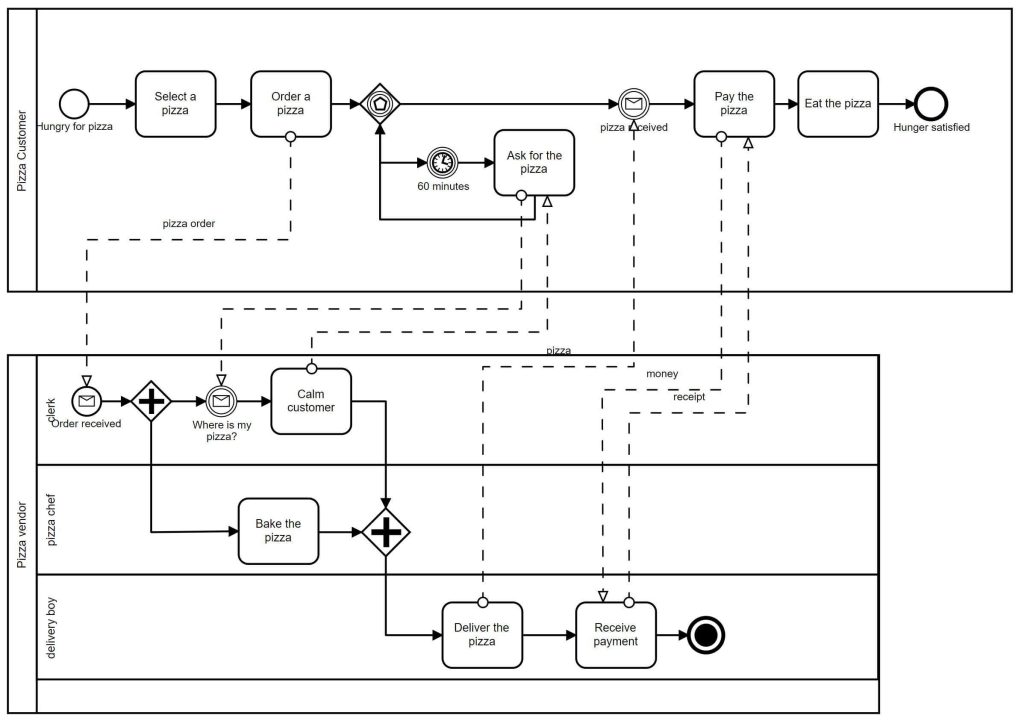
Analysis and rework: Optimize processes
Visualized as-is processes are the starting point for uncovering optimization potential and eliminating technical, business, or organizational weaknesses. The desired target processes should achieve maximum efficiency with fast throughput times and low costs in order to achieve the business objective. Review the modeled as-is processes from the three aspects below:
- Reduction: Are all tasks in the process indispensable?
- Simplification: Could tasks be done in a simpler way?
- Standardization: Is there a uniform procedure for processing defined tasks?
Reduction, simplification, and standardization can already significantly increase process efficiency and effectively reduce process costs. Moreover, optimized processes pave the way to profitable, sustainable, and scalable RPA projects. If you lack professional resources for preliminary process optimization, it may be worthwhile to call in external process consulting.
Candidates for automation: Evaluate tasks with the right criteria
The preliminary process optimization is completed and the target processes are in place. You can now consider whether individual tasks are suitable for automation with RPA. To do so, take a look at possible use cases from two perspectives. First, from a technological or process logical point of view: can this task be automated? Second, from a business perspective: is it worth automating this task? There’s a bunch of criteria you can rely on when it comes to task evaluation.
RPA criteria I: Automation capability
Digital data input. RPA bots work on graphical user interfaces of digital applications. Only tasks that your employees do manually on a PC can be automated with RPA. Identify remaining paper-based tasks in your processes and digitize them. For example, generate proposals and contracts with digital signatures instead of handwritten ones. Capture minutes and meeting notes digitally. Maintain electronic employee files and digitize work time recording and vacation requests. Suppose you also want to reach your customers by analog mail? Use electronic letter dispatch.
Structured and standardized data input. The more uniformly the data to be processed is formatted, the easier it is to develop a suitable RPA bot. For example, if you want to automate the processing of typical customer service requests, offer your customers matching web forms with standardized fields and predefined input values. This way, you enforce a structured data input that an RPA bot can process better than a commonly unstructured communication via email
Defined process trigger. There should be a clear digital trigger to start the RPA process autonomously. For example, an email informs about the successful shipment of goods to the customer and thus triggers the automated invoicing.
Stability of digital systems. Automate processes in systems that will not change in the foreseeable future, so no new applications should be introduced into the process or changes made to the user interface of existing applications. Any change will require redevelopment or adaptation of the RPA bots.
Stability of the processes. The process flow should already be optimized so that no changes need to be made to the flow in the near future and the associated adjustments to the RPA bots. That is why preliminary process optimization is essential.
Rules-based processes. Processes must follow distinct logical rules and decision trees (if X, then Y). Despite this, a few process steps where no clear rules can be defined may remain – these will still require human judgment. The bot can delegate these as "human tasks" to employees for manual processing. Subsequently, the "attended bot" continues to automate the process.
Standard processes with few process variants. Each process variant takes additional effort for bot development. So choose a standard process with the lowest possible rate of special cases for automation, or automate only the "happy path," and hand over process variants to manual processing.
RPA criteria II: Profitability
High manual effort. A basic selection criterion for RPA candidates is a high level of manual effort when processing the task, e.g. aggregating data from multiple systems to generate a report. If one click is enough to complete this task, the savings potential through automation is rather low.
Repetitive nature. Another indicator of profitability is the frequency or repetition of process execution. Repeated routine tasks that would have to be performed daily or weekly should definitely be looked at.
Process volume. Some processes occur less frequently, but regularly generate a high volume of work in the specialist departments, e.g. monthly payroll in HR, the annual financial statements in financial accounting, or the high volume of orders during the holiday season. RPA can relieve temporary peak workloads.
Process costs vs. RPA costs. Based on task processing times and employees’ hourly pay rates, identify the actual process costs to determine the savings potential. Compare these figures with the cost of RPA, i.e. the initial costs for bot development and the ongoing costs for maintenance and license fees. If the savings potential exceeds the initial and ongoing RPA costs immediately or in the foreseeable future, automation is worthwhile.
Qualify your processes with MuleSoft RPA
Only on the basis of a clean process documentation and comprehensive process assessment can you harness the full potential of RPA and establish a scalable automation landscape in your organization. As a holistic automation solution, MuleSoft RPA integrates the complete RPA lifecycle, including the process evaluation and process modeling phases in BPMN 2.0.
MuleSoft RPA process evaluation
Automation ability is assessed per automation qualifiers and automation benefits, process costs, duration time, and frequency:
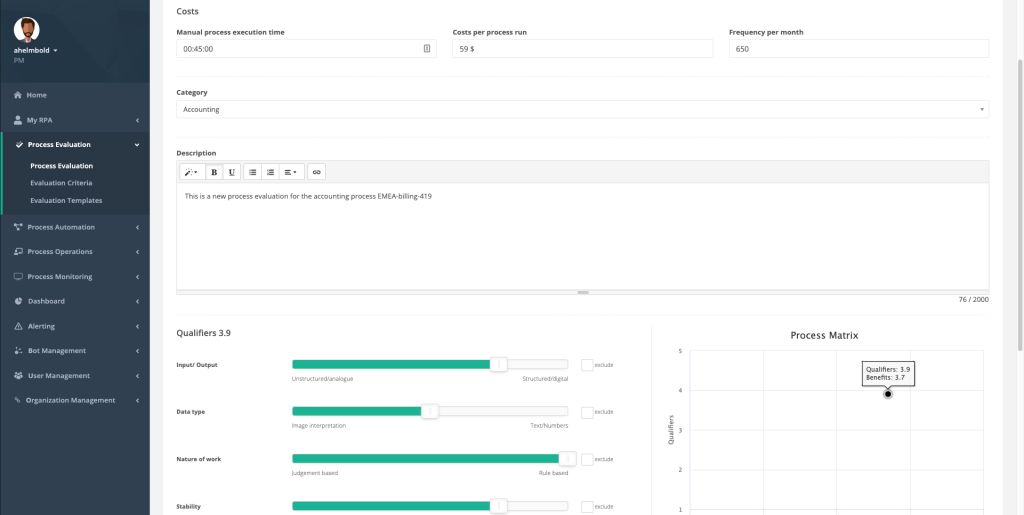
Evaluated processes are prioritized in an RPA pipeline, and displayed in a list as well as a heatmap view:
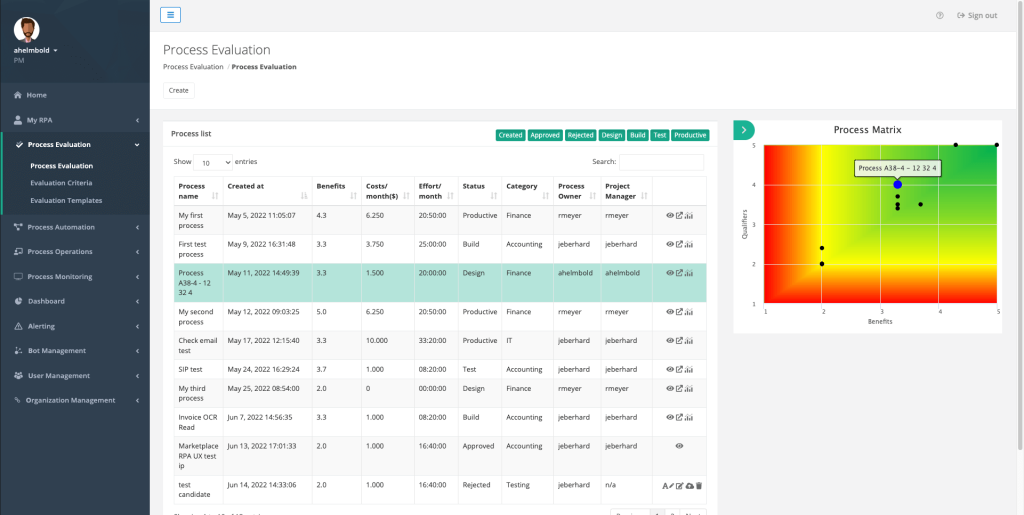
MuleSoft RPA process design
BPMNs can either be uploaded or be built from scratch:
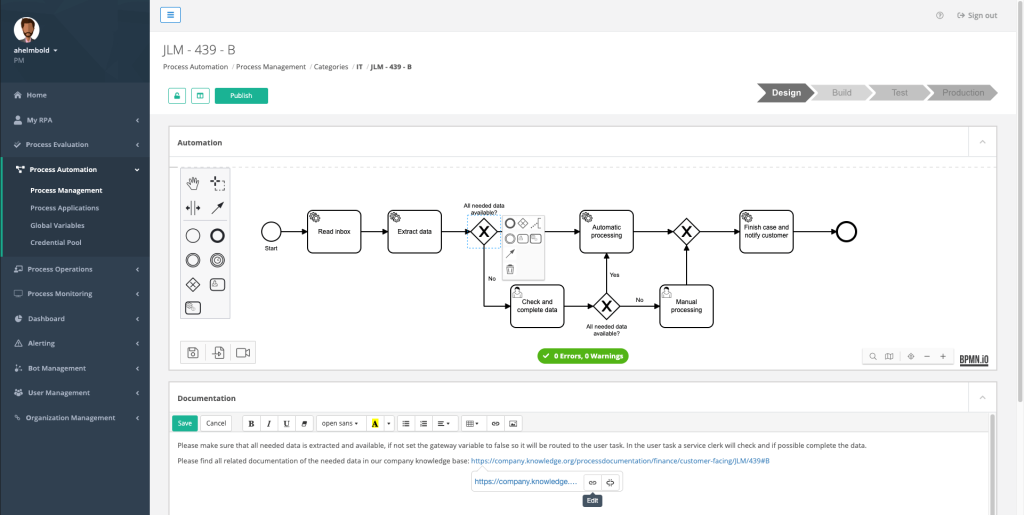
MuleSoft RPA workflow build
Each BPMN process step refers to an activity workflow the RPA bot will execute. The bot workflows are built via a no-code drag-and-drop procedure with pre-built action steps stored in a comprehensive toolbox:
>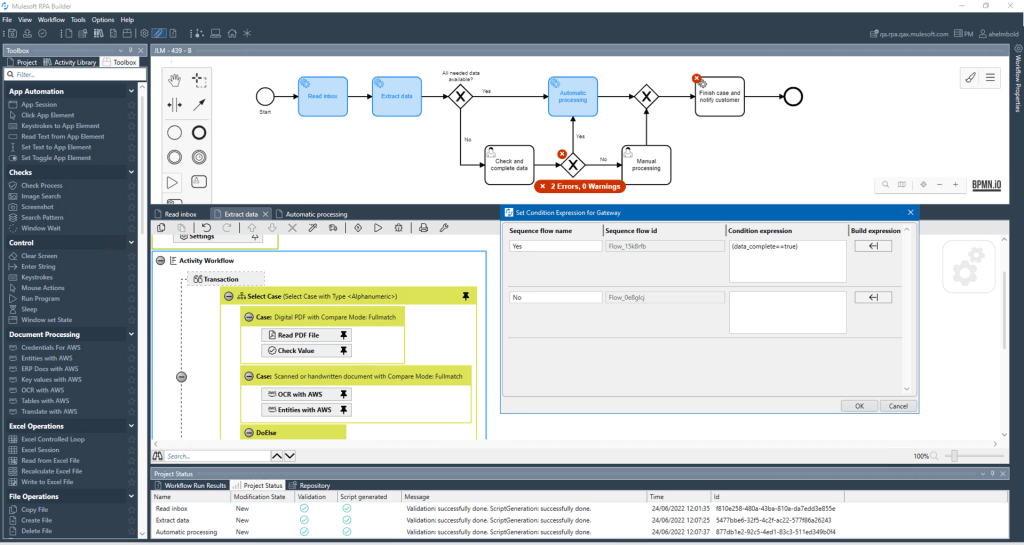
Process automation through the entire RPA lifecycle
You can use MuleSoft RPA to evaluate processes, model processes, create RPA workflows, and much more. Discover all the features and functionalities of MuleSoft RPA and how you can use it for your business.



